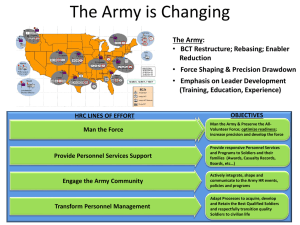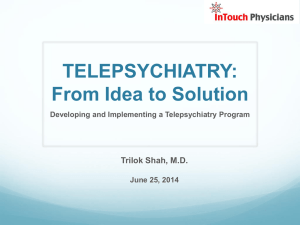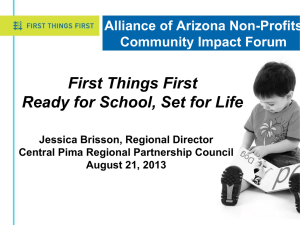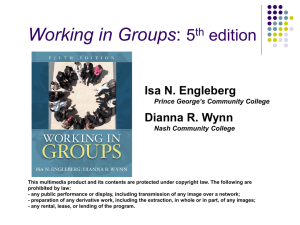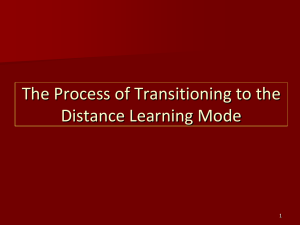Family to Family NAMI Family to Family Program
advertisement
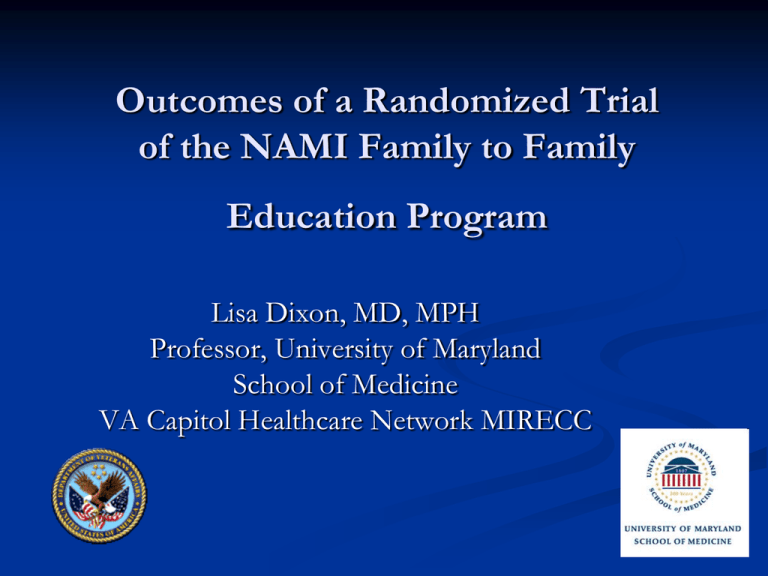
Outcomes of a Randomized Trial of the NAMI Family to Family Education Program Lisa Dixon, MD, MPH Professor, University of Maryland School of Medicine VA Capitol Healthcare Network MIRECC Research Partnership University of Maryland School of Medicine: Lisa Dixon, Alicia Lucksted, Bette Stewart, Tony Lehman, Aaron Murray-Swank, Deborah Medoff, Alan Bellack, Li Juan Fang, Vera Sturm, Wendy Potts National Alliance on Mental Illness: Joyce Burland, Maryland Affiliates Baltimore Metro, Frederick, Howard, Montgomery, Prince George’s, FTF Teachers Rationale Evidence suggests that clinical programs and professionals have limited contact with families, leaving families with unmet needs and less able to be helpful for the recovery of their ill family members The NAMI Family to Family program was created by family members to help meet the needs of families of persons with mental illness Research Background Two previous studies have suggested that NAMI FTF reduces family subjective burden, increases empowerment, and increases self-perceived knowledge One previous randomized trial of Journey of Hope, an 8-session family led program, showed some benefits in depression, vitality, and perceptions of family member No previous randomized trial of NAMI FTF, the largest and most widely disseminated family program in the country Dixon L, Stewart B, Burland J, Delahanty J, Lucksted A, Hoffman M: Pilot study of the effectiveness of the Family-to-Family Education Program, Psychiatric Services 2001;52:965-967. Dixon L, Lucksted A, Stewart B, Burland J, Brown C, Postrado L, McGuire C, Hoffman M.: Outcomes of the Peer-Taught 12Week Family-to-Family Education Program for SMI, Acta Psychiatrica Scandinavica 2004:109, 207-215 Family to Family Developed by Dr. Joyce Burland (NAMI Vermont) in 1991. Now taught by over 6,000 trained NAMI family-member volunteers in 49 U.S. states, 2 Canadian Provinces, Mexico and Italy. Most widely available family info & support program in the U.S. NAMI Family to Family Program Structured 12-week program with weekly 2-3 hour sessions Trauma-recovery and stress-coping model The course is taught by trained family members. Curriculum focuses on: Schizophrenia, Borderline Personality Disorder, Bipolar disorder, Clinical depression, Panic disorder, PTSD, Obsessive-compulsive disorder Hypotheses When compared to control condition participants, FTF participants will have… Increased empowerment (primary) Increased knowledge of mental illness (primary) Reduced subjective burden (primary) Increased emotion-focused coping (secondary) Reduced distress (secondary) Improved family functioning (secondary) Reduced negative aspects of caregiving (exploratory) Increased positive aspects of caregiving (exploratory) Hypotheses Benefits at program completion will be sustained six months later. Design Randomized trial of family members Participants assigned to immediate FTF vs. any desired supports other than FTF + spot in next FTF class Participant assessment at baseline prior to randomization and then three months later Interviewer blinded to study condition Participants randomized to FTF also interviewed 6 months after completion of class FTF classes conducted naturally as they always are Participants enrolled from 3/15/06 to 9/23/09 Participant Recruitment All individuals who called participating NAMI affiliate about FTF were directed to Bette Stewart, the state’s NAMI FTF coordinator and UMB staff member Bette Stewart assessed if FTF was appropriate for the person, and if so, if they were interested in the study If yes, they were referred to research team for possible enrollment, informed consent process, assessment and randomization. If no, Bette assisted them in enrolling in FTF Comparison of Study Participants v. Decliners Declined (N=857) Consented in FTF Comparison Study (N=314) Age 53.5 (11.6) 51.9 (10.9) P<.05 Caucasian (%) 68% 66% ns Gender (% Male) 29% 23% P<.05 N=118, 38% ns County Baltimore Metro N= 316, 37% Montgomery N=284, 33% Frederick N=87, 10% Howard N=146, 17% Prince George’s N=24, 3% N=97, 31% N=45, 14% N=49, 16% N=5, 2% Characteristics of Study Participants (n=313) Percentage of Participants Characteristics of Study Participants (n=313) Percentage of Participants FTF Classes Attended by FTF Participants Percentage of Participants 80 68 70 60 50 40 30 20 13 10 9 10 1 to 4 5 to 8 0 None Number of Classes Attended 9 to 12 What other assistance did participants in the study obtain during the 3-month study period? NAMI Supports used during the 3month Study Period Percentage of Participants Mental Health Supports during 3-month Study Period Percentage of Participants Informal Supports during 3-month Study Period Percentage of Participants Fidelity Randomly selected class from each course was evaluated on 18 essential elements by visiting FTF teacher Average rating: 90% (SD=7.54). Only one class scored less than 75%. Additional class-meeting evaluated during that session achieved >90% Results Empowerment in Family (FES Family Subscale) 4 3.9 3.8 3.7 3.6 P=.027, ES=.31 3.5 FTF Control P<.001 (BL vs. 9-Mo) 3.4 3.3 3.2 3.1 3 Pre-F2F 3-Month FTF=133, Control=126 9-Month Empowerment in Service System (FES Service System Subscale) 3.6 3.5 3.4 P=.012, ES=.42 3.3 P<.01 (BL vs. 9-Mo) 3.2 3.1 3 2.9 2.8 Pre-F2F 3-Month FTF=133, Control=126 9-Month FTF Control Empowerment in Community (FES Community Subscale) 3.6 3.4 3.2 3 P=.005, ES=.50 FTF Control 2.8 2.6 P<.001 (BL vs. 9-Mo) 2.4 2.2 2 Pre-F2F 3-Month FTF=133, Control=126 9-Month Knowledge Test 70 68 66 64 62 P=.016, ES=.40 P<.001 (BL vs. 9-Mo) FTF Control 60 58 56 54 52 50 Pre-F2F 3-Month FTF=133, Control=126 9-Month Subjective Burden (FEIS Worry Subscale) 3 2.9 2.8 2.7 2.6 NS FTF Control 2.5 2.4 2.3 2.2 2.1 2 P<.001 (BL vs. 9-Mo) Pre-F2F 3-Month FTF=133, Control=126 9-Month Subjective Burden (FEIS Displeasure Subscale) 3 2.9 2.8 2.7 2.6 NS FTF Control 2.5 2.4 2.3 2.2 2.1 2 P<.001 (BL vs. 9-Mo) Pre-F2F 3-Month FTF=133, Control=126 9-Month Emotion Focused Coping (COPE Acceptance Subscale) 14 13.8 13.6 13.4 13.2 P=.006, ES=.38 P<.001 (BL vs. 9-Mo) FTF Control 13 12.8 12.6 12.4 12.2 12 Pre-F2F 3-Month FTF=133, Control=126 9-Month Emotion Focused Coping (COPE Positive Subscale) 13 12.8 12.6 12.4 12.2 12 11.8 11.6 11.4 11.2 11 P<.01 (BL vs. 9-Mo) FTF Control NS Pre-F2F 3-Month FTF=133, Control=126 9-Month Distress (CGI Anxiety Subscale) 55 54 53 52 51 50 P<.01 (BL vs. 9-Mo) FTF Control P=.04, ES=.26 49 48 47 46 45 Pre-F2F 3-Month FTF=133, Control=126 9-Month Distress (CGI Depression Subscale) 55 54 53 52 51 50 P<.001 (BL vs. 9-Mo) FTF Control NS 49 48 47 46 45 Pre-F2F 3-Month FTF=133, Control=126 9-Month Distress (CGI Global Score)) 55 54 53 52 51 50 P<.01 (BL vs. 9-Mo) FTF Control P=.081, ES=.22 49 48 47 46 45 Pre-F2F 3-Month FTF=133, Control=126 9-Month Family System Functioning (Problem Solving Scale) 13.5 13.3 13.1 12.9 12.7 12.5 12.3 12.1 11.9 11.7 11.5 FTF Control P=.02 (BL vs. 9-Mo) P=.019, ES=.30 Lower scores reflect Better functioning. Pre-F2F 3-Month FTF=133, Control=126 9-Month Family System Functioning (General Functioning Scale) 30 29 28 27 26 25 24 23 22 21 20 P<.01 (BL vs. 9-Mo) NS Pre-F2F 3-Month FTF=133, Control=126 9-Month FTF Control Experience of Caregiving (ECI Positive Scale) 5 4.9 4.8 4.7 4.6 P=<.001, ES=.46 P=.20 (BL vs. 9-Mo) 4.5 4.4 4.3 4.2 4.1 4 Pre-F2F 3-Month FTF=133, Control=126 9-Month FTF Control Experience of Caregiving (ECI Negative Scale) 16 15.5 15 14.5 14 13.5 P=<.001 (BL vs. 9-Mo) NS 13 12.5 12 11.5 11 Pre-F2F 3-Month FTF=133, Control=126 9-Month FTF Control FTF Classes Attended by FTF Participants Percentage of Participants 80 68 70 60 50 40 30 20 13 10 9 10 1 to 4 5 to 8 0 None Number of Classes Attended 9 to 12 Distress (CGI Depression Subscale) Those Who Attended at least one Class) 55 54 53 52 51 50 P<.001 (BL vs. 9-Mo) FTF Control P=.03 49 48 47 46 45 Pre-F2F 3-Month FTF=116, Control=126 9-Month Depression (CESD) Those Who Attended at least one Class) 10 9.5 9 8.5 FTF Control 8 P=.03 P=.053 (BL vs. 9-Mo) 7.5 7 6.5 Pre-F2F 3-Month FTF=116, Control=126 9-Month Summary The study findings supported the hypotheses that FTF improves empowerment, knowledge and emotion-focused coping of family members reduces the anxiety and possibly depression experienced by family members improves the functioning of family members with respect to problem solving skills benefits retained at 6 months What Do The Results Mean? Small to moderate effect sizes Changes observed on the FAD problem solving and COPE acceptance scales are consistent with reports in the literature in which these scales are used to differentiate clinical from non-clinical samples or changes in clinical samples with treatment over time Changes more complex than measures? What Do The Results Mean? Benefits are readily understood in terms of self-help theory, stress/coping and trauma/recovery models Dr. Burland conceived of FTF as a way to change the “consciousness” of family members. What Do The Results Mean? Qualitative study echoed quantitative results and suggested that the growth in empowerment and coping as well as reductions in distress together produced very meaningful benefits in the lives of FTF participants FTF experienced produced marked immediate positive global benefits with the promise of longer term growth. Fit With Qualitative Study New Info. & Support Early suggested that new info + support + skills = changes in awareness, more active coping, increased empowerment, Which help reduce distress, improve family relating, and leads to broader benefits. Lucksted, Stewart, Forbes, 2008 Engmt Insights & Acceptance Emotional Changes New Tools & Skills New Ways of Acting Immediate Benefits Global Benefits Conclusions Evidence that relatively brief peer-taught family interventions enhance family outcomes. And that such peer-led family programs are important in the toolkit of approaches to help families of persons with mental illness Next Steps NAMI and supporters continue to expand FTF with this research evidence helping. Additional analyses will focus on “decliner” sample. Did people in the RCT differ from those not willing to sign up? Did FTF benefit some subgroups of family members more than others? Look at limited data on consumers Future Research To understand and possibly improve FTF’s impact on consumer outcomes and wellbeing Strategies to promote linkage of FTF (or related) with mental health system, more access Enhancing FTF’s “reach” via mobile, online tools Timeline PORT Contract (92-97) NIMH Center Grant (95-00)(Steinwachs), K Award (95-99) RWJF Grant FTF Controlled Trial (2000-2002) NIMH R01 Randomized Trial (2005-2009) Grants 1990 2000 2010 Pubs PORT Family Psychoed EBP (Sz Bull, 1995) State funding for Family Services: FTF (PS,1999) Pre-post Pilot Study of FTF (PS, 2001) WL Control FTF Study (Acta, 2004) Thanks to all for making this happen! For further discussion, if time Improved Communication The communications skills really helped us not to fight as much. [Before] it was a constant fight with [sister], and then when we started looking at the communication skills and learning all of the other stuff in Family-to- Family … Instead of isolating her and her always feeling like we were blaming her and that everybody was against her, she even said she started to feel like we were really supporting her and that we were on her side. Letting go of ‘‘trying to control everything’’ It helped me to see there is nothing I can do to solve the problems she has, but there are ways I can help. Feeling better “equipped” Literally, the next two days after I had that communication class, [my daughter] called me up and bawled me out. And I tried everything and it didn’t work (laughter) but I felt better for having tried it. Because sometimes nothing’s going to work no matter what you do—[but] I had something to try. Multifaceted Effects I just don’t think my parents knew how to handle it well and they didn’t know what steps to take and so bringing them to NAMI was huge for me and for them because it just showed them there’s a million things we can be doing that we’ve never even thought about doing before. Multifaceted Effects The NAMI program actually saved our marriage. As a matter of fact, may even have saved my wife’s life. Gaining insight into the illness has given me the strength to keep working on the relationship. Learning what I know about depression has helped me make better decisions when my wife is getting symptomatic. Emotionally I feel a lot stronger, a lot better. That’s the word I want to use.
